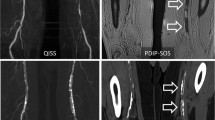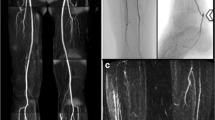Abstract
Objective
To evaluate the potential clinical benefit of the superior spatial resolution of 3D prototype thin-slab stack-of-stars (tsSOS) quiescent-interval slice-selective (QISS) MRA over standard 2D-QISS MRA for the detection peripheral artery disease (PAD), using computed tomography angiography (CTA) as reference.
Materials and methods
Twenty-three patients (70 ± 8 years, 18 men) with PAD who had previously undergone run-off CTA were prospectively enrolled. Patients underwent non-contrast MRA using 2D-QISS and tsSOS-QISS at 1.5 T. Eighteen arterial segments were evaluated for subjective and objective image quality (normalized signal-to-noise, nSNR), vessel sharpness, and area under the curve (AUC) for > 50% stenosis detection.
Results
Overall subjective image quality ratings for the entire run-off were not different between tsSOS-QISS and 2D-QISS (3 [3; 4] vs 4 [3; 4], respectively; P = 0.813). Sharpness of primary branch vessels demonstrated improved image quality using tsSOS-QISS compared with 2D-QISS (4 [3; 4] vs 3 [2; 3], P = 0.008). Objective image quality measures were not different between 2D-QISS and tsSOS-QISS (nSNR 5.0 ± 1.9 vs 4.2 ± 1.8; P = 0.132). AUCs for significant stenosis detection by tsSOS-QISS and 2D-QISS were 0.877 and 0.856, respectively (P = 0.336).
Discussion
The prototype 3D tsSOS-QISS technique provides similar accuracy in patients with PAD to a standard commercially available 2D-QISS technique, indicating that the use of relatively thick slices does not limit the diagnostic performance of 2D-QISS. However, subjective image quality for branch vessel depiction is improved using the 3D approach.




Similar content being viewed by others
References
Selvin E, Erlinger TP (2004) Prevalence of and risk factors for peripheral arterial disease in the United States: results from the National Health and Nutrition Examination Survey, 1999–2000. Circulation 110(6):738–743
Norgren L, Hiatt WR, Dormandy JA, Nehler MR, Harris KA, Fowkes FG, Rutherford RB, Group TIW (2007) Inter-society consensus for the management of peripheral arterial disease. Int Angiol 26(2):81–157
Rooke TW, Hirsch AT, Misra S, Sidawy AN, Beckman JA, Findeiss L, Golzarian J, Gornik HL, Jaff MR, Moneta GL, Olin JW, Stanley JC, White CJ, White JV, Zierler RE, American College of Cardiology Foundation Task F, American Heart Association Task F (2013) Management of patients with peripheral artery disease (compilation of 2005 and 2011 ACCF/AHA Guideline Recommendations): a report of the American College of Cardiology Foundation/American Heart Association Task Force on Practice Guidelines. J Am Coll Cardiol 61(14):1555–1570
Davenport MS, Khalatbari S, Cohan RH, Dillman JR, Myles JD, Ellis JH (2013) Contrast material-induced nephrotoxicity and intravenous low-osmolality iodinated contrast material: risk stratification by using estimated glomerular filtration rate. Radiology 268(3):719–728
Menke J, Larsen J (2010) Meta-analysis: accuracy of contrast-enhanced magnetic resonance angiography for assessing steno-occlusions in peripheral arterial disease. Ann Intern Med 153(5):325–334
Kuo PH, Kanal E, Abu-Alfa AK, Cowper SE (2007) Gadolinium-based MR contrast agents and nephrogenic systemic fibrosis. Radiology 242(3):647–649
Gulani V, Calamante F, Shellock FG, Kanal E, Reeder SB, International Society for Magnetic Resonance in M (2017) Gadolinium deposition in the brain: summary of evidence and recommendations. Lancet Neurol 16(7):564–570
Edelman RR, Sheehan JJ, Dunkle E, Schindler N, Carr J, Koktzoglou I (2010) Quiescent-interval single-shot unenhanced magnetic resonance angiography of peripheral vascular disease: technical considerations and clinical feasibility. Magn Reson Med 63(4):951–958
Varga-Szemes A, Wichmann JL, Schoepf UJ, Suranyi P, De Cecco CN, Muscogiuri G, Caruso D, Yamada RT, Litwin SE, Tesche C, Duguay TM, Giri S, Vliegenthart R, Todoran TM (2017) Accuracy of noncontrast quiescent-interval single-shot lower extremity MR angiography versus CT angiography for diagnosis of peripheral artery disease: comparison with digital subtraction angiography. JACC Cardiovasc Imaging 10(10):1116–1124
Wu G, Yang J, Zhang T, Morelli JN, Giri S, Li X, Tang W (2016) The diagnostic value of non-contrast enhanced quiescent interval single shot (QISS) magnetic resonance angiography at 3T for lower extremity peripheral arterial disease, in comparison to CT angiography. J Cardiovasc Magn Reson 18(1):71
Varga-Szemes A, Aherne EA, Schoepf UJ, Todoran TM, Koktzoglou I, Edelman RR (2019) Free-breathing fast low-angle shot quiescent-interval slice-selective magnetic resonance angiography for improved detection of vascular stenoses in the pelvis and abdomen: technical development. Invest Radiol 54(12):752–756
Hansmann J, Morelli JN, Michaely HJ, Riester T, Budjan J, Schoenberg SO, Attenberger UI (2014) Nonenhanced ECG-gated quiescent-interval single shot MRA: image quality and stenosis assessment at 3 tesla compared with contrast-enhanced MRA and digital subtraction angiography. J Magn Reson Imaging 39(6):1486–1493
Hodnett PA, Koktzoglou I, Davarpanah AH, Scanlon TG, Collins JD, Sheehan JJ, Dunkle EE, Gupta N, Carr JC, Edelman RR (2011) Evaluation of peripheral arterial disease with nonenhanced quiescent-interval single-shot MR angiography. Radiology 260(1):282–293
Klasen J, Blondin D, Schmitt P, Bi X, Sansone R, Wittsack HJ, Kropil P, Quentin M, Kuhlemann J, Miese F, Heiss C, Kelm M, Antoch G, Lanzman RS (2012) Nonenhanced ECG-gated quiescent-interval single-shot MRA (QISS-MRA) of the lower extremities: comparison with contrast-enhanced MRA. Clin Radiol 67(5):441–446
Cavallo AU, Koktzoglou I, Edelman RR, Gilkeson R, Mihai G, Shin T, Rajagopalan S (2019) Noncontrast magnetic resonance angiography for the diagnosis of peripheral vascular disease. Circ Cardiovasc Imaging 12(5):e008844
Edelman RR, Aherne E, Leloudas N, Pang J, Koktzoglou I (2020) Near-isotropic noncontrast MRA of the renal and peripheral arteries using a thin-slab stack-of-stars quiescent interval slice-selective acquisition. Magn Reson Med 83(5):1711–1720
Thierfelder KM, Meimarakis G, Nikolaou K, Sommer WH, Schmitt P, Kazmierczak PM, Reiser MF, Theisen D (2014) Non-contrast-enhanced MR angiography at 3 Tesla in patients with advanced peripheral arterial occlusive disease. PLoS ONE 9(3):e91078
Markl M, Alley MT, Elkins CJ, Pelc NJ (2003) Flow effects in balanced steady state free precession imaging. Magn Reson Med 50(5):892–903
Fraioli F, Catalano C, Napoli A, Francone M, Venditti F, Danti M, Pediconi F, Passariello R (2006) Low-dose multidetector-row CT angiography of the infra-renal aorta and lower extremity vessels: image quality and diagnostic accuracy in comparison with standard DSA. Eur Radiol 16(1):137–146
Salehi Ravesh M, Tesch K, Lebenatus A, Koktzoglou I, Edelman RR, Eden M, Langguth P, Graessner J, Jansen O, Both M (2020) Clinical value of noncontrast-enhanced radial quiescent-interval slice-selective (QISS) magnetic resonance angiography for the diagnosis of acute pulmonary embolism compared to contrast-enhanced computed tomography and cartesian balanced steady-state free precession. J Magn Reson Imaging 52(5):1510–1524
Robison RO, Blatter DD, Parker DL, Barney WW, Perry DM, Goodrich KC (1994) Reduction of slab boundary artifact with multiple overlapping thin slab acquisition in MR angiography of the cervical carotid artery. J Magn Reson Imaging 4(4):529–535
Haji-Valizadeh H, Collins JD, Aouad PJ, Serhal AM, Lindley MD, Pang J, Naresh NK, Carr JC, Kim D (2019) Accelerated, free-breathing, noncontrast, electrocardiograph-triggered, thoracic MR angiography with stack-of-stars k-space sampling and GRASP reconstruction. Magn Reson Med 81(1):524–532
Varga-Szemes A, Penmetsa M, Emrich T, Todoran TM, Suranyi P, Fuller SR, Edelman RR, Koktzoglou I, Schoepf UJ (2020) Diagnostic accuracy of non-contrast quiescent-interval slice-selective (QISS) MRA combined with MRI-based vascular calcification visualization for the assessment of arterial stenosis in patients with lower extremity peripheral artery disease. Eur Radiol. https://doi.org/10.1007/s00330-020-07386-4
Edelman RR, Koktzoglou I (2021) “Push-button” noncontrast MR angiography using balanced T1 relaxation-enhanced steady-state (bT1RESS). Magn Reson Med 85(3):1248–1257
Koktzoglou I, Huang R, Ong AL, Aouad PJ, Walker MT, Edelman RR (2020) High spatial resolution whole-neck MR angiography using thin-slab stack-of-stars quiescent interval slice-selective acquisition. Magn Reson Med 84(6):3316–3324
Nakamura K, Miyazaki M, Kuroki K, Yamamoto A, Hiramine A, Admiraal-Behloul F (2011) Noncontrast-enhanced peripheral MRA: technical optimization of flow-spoiled fresh blood imaging for screening peripheral arterial diseases. Magn Reson Med 65(2):595–602
Miyazaki M, Takai H, Sugiura S, Wada H, Kuwahara R, Urata J (2003) Peripheral MR angiography: separation of arteries from veins with flow-spoiled gradient pulses in electrocardiography-triggered three-dimensional half-Fourier fast spin-echo imaging. Radiology 227(3):890–896
Lim RP, Hecht EM, Xu J, Babb JS, Oesingmann N, Wong S, Muhs BE, Gagne P, Lee VS (2008) 3D nongadolinium-enhanced ECG-gated MRA of the distal lower extremities: preliminary clinical experience. J Magn Reson Imaging 28(1):181–189
Fan Z, Sheehan J, Bi X, Liu X, Carr J, Li D (2009) 3D noncontrast MR angiography of the distal lower extremities using flow-sensitive dephasing (FSD)-prepared balanced SSFP. Magn Reson Med 62(6):1523–1532
Priest AN, Joubert I, Winterbottom AP, See TC, Graves MJ, Lomas DJ (2013) Initial clinical evaluation of a non-contrast-enhanced MR angiography method in the distal lower extremities. Magn Reson Med 70(6):1644–1652
Shin T, Hu BS, Nishimura DG (2013) Off-resonance-robust velocity-selective magnetization preparation for non-contrast-enhanced peripheral MR angiography. Magn Reson Med 70(5):1229–1240
Shin T, Worters PW, Hu BS, Nishimura DG (2013) Non-contrast-enhanced renal and abdominal MR angiography using velocity-selective inversion preparation. Magn Reson Med 69(5):1268–1275
Qin Q, Shin T, Schar M, Guo H, Chen H, Qiao Y (2016) Velocity-selective magnetization-prepared non-contrast-enhanced cerebral MR angiography at 3 Tesla: improved immunity to B0/B1 inhomogeneity. Magn Reson Med 75(3):1232–1241
Funding
This study was funded by NIH NHLBI R01 HL130093 (RRE).
Author information
Authors and Affiliations
Corresponding author
Ethics declarations
Conflict of interest
Akos Varga-Szemes receives institutional research and travel support from Siemens Healthcare and is a consultant for Bayer and Elucid Bioimaging. U. Joseph Schoepf is a consultant for and/or receives research support from Bayer, Bracco, Elucid Bioimaging, Guerbet, HeartFlow, and Siemens Healthcare. Tilman Emrich receives travel support and speaker fee from Siemens Healthcare. Ioannis Koktzoglou receives research support from Siemens Healthcare. Robert R. Edelman receives grant support and royalties from Siemens Healthcare. The other authors have no conflicts of interest to disclose.
Ethical approval
All procedures performed in studies involving human participants were in accordance with the ethical standards of the institutional and/or national research committee and with the 1964 Helsinki Declaration and its later amendments or comparable ethical standards.
Informed consent
Informed consent was obtained from all individual participants included in the study.
Additional information
Publisher's Note
Springer Nature remains neutral with regard to jurisdictional claims in published maps and institutional affiliations.
Rights and permissions
About this article
Cite this article
Varga-Szemes, A., Aouad, P., Schoepf, U.J. et al. Comparison of 2D and 3D quiescent-interval slice-selective non-contrast MR angiography in patients with peripheral artery disease. Magn Reson Mater Phy 34, 649–658 (2021). https://doi.org/10.1007/s10334-021-00927-y
Received:
Revised:
Accepted:
Published:
Issue Date:
DOI: https://doi.org/10.1007/s10334-021-00927-y




